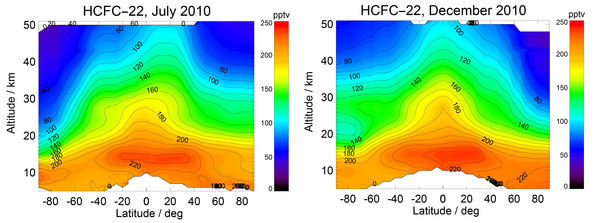HCFC-22 is a perfect tracer for troposphere-stratosphere transport

The figure shows the zonal mean distributions of HCFC-22 for July and December 2010. HCFC-22 is produced anthropogenically and destroyed in the stratosphere. Production is restricted by the Montreal protocol, so that it is almost uniquely produced in East Asia nowadays. This makes HCFC-22 to a perfect tracer for transport of East-Asian pollution by the Asian monsoon anticyclone. The maximum seen in the zonal mean distributions in the Tropical and Northern subtropic upper troposphere comes from the upward transport of enormous abundances from South-East China and India in the Asian monsoon. HCFC-22 reaches the Asian monsoon anticyclone and is transported from there into the tropical tropopause layer, from where it is uplifted in the tropical pipe into the stratosphere. A significant vertical transport directly through the Asian monsoon tropopause can almost certainly be excluded. Another nice feature in the zonal mean distributions is the transport of HCFC-22-rich mid-latitude air into the Austral spring/summer polar region in a rather confined layer between 25 and 35 km. Below this layer the remnant of polar vortex air with lower HCFC-22 values is still visible.
HCFC-22 has been derived from MIPAS data for the full mission period. The reduced-resolution data from 2005 to 2012 are analysed within the paper mentioned below. HCFC-22 has been validated against ACE-FTS, MkIV, surface and balloon-borne in-situ data, and the trend of HCFC-22 dependent on latitude and altitude has been derived. The trends, after correction for the trends at the surface, i.e. the "unexplained" trends, are hemispherically asymmetric and hint towards a change of the stratospheric circulation pattern.
Further details can be found here: http://www.atmos-chem-phys.net/16/3345/2016/
